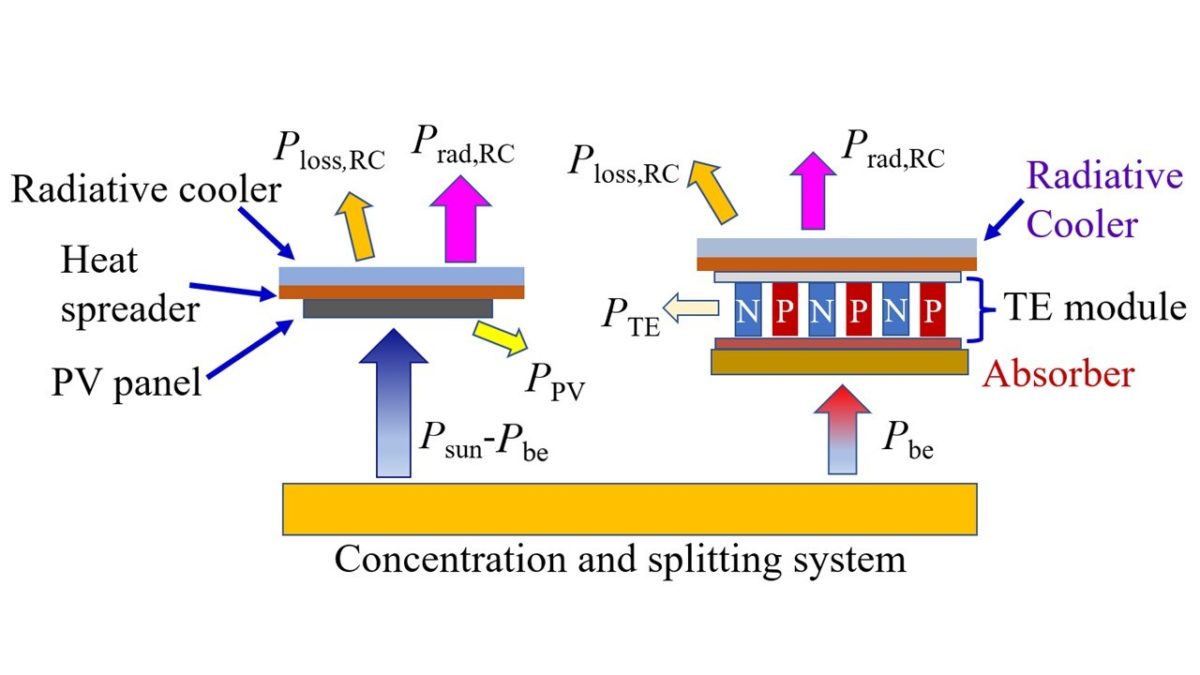Scientists from the Chinese Academy of Science have designed a hybrid power system that combines photovoltaics, spectral-splitting (SS), radiative cooling (RC), and a thermoelectric (TEG) unit.
“The proposed system can be applied to solar photovoltaic power generation, with the thermoelectric materials using the separated solar spectrum to generate electricity,” researcher Jianfeng Guo told pv magazine. “At the same time, the combination of radiation cooling technology and thermoelectric materials can realize power generation at night.”
In the proposed ideal system configuration, the photovoltaic panel is based on heterojunction cells made of III-V materials, placed at the bottom of the hot side of the TEG to generate electricity using the temperature difference between the PV panel and radiative cooling.
“Radiative cooling needs to face the sky, so it is placed on the top,” said the scientists.
Radiative cooling occurs when the surface of an object absorbs less radiation from the atmosphere and emits more. As a result, the surface loses heat and a cooling effect can be achieved without the need for power.
The performance of the system was compared to that of a “conventional” PV-TEG system, in which the PV panel stays on the top acting as the hot side of TEG, and a heat sink is used as the cold side of TEG at the bottom. The TEG module uses numerous P-N thermocouples and is placed in the middle, to generate electricity using the temperature difference between the solar panel and heat sink.
For the comparison, they applied a theory based on heat-flux conditions is employed to achieve maximum thermoelectric efficiency.
“The PV-TEG hybrid system with RC is superior to the conventional hybrid system, not only in terms of higher efficiency but also in its 24-h operation capacity,” the scientists stated.
They found that the hybrid system with four-junction cells could potentially achieve an efficiency of more than 65%, which they described as superior to most current photoelectric and thermal power systems. A system with a single-junction, efficiency reached 39.4%, and they said that this was higher than the theoretical PV efficiency at 500 suns of 38.2%.
“We only carried out theoretical analysis and numerical simulation on this system, without economic analysis,” Guo said. “In the future, we are going to build an experimental system, and then we will conduct cost analysis.”
The researchers introduced the system in “Maximizing Electric Power through Spectral-Splitting Photovoltaic-Thermoelectric Hybrid System Integrated with Radiative Cooling,” which was recently published in Advanced Science.
Radiative cooling was recently applied to solar panel cooling by researchers from Shanghai Jiao Tong University in China, Purdue University in the United States, the Catalan Institute of Nanoscience and Nanotechnology and the Instituto de Ciencia de Materiales in Spain, and the Jordan University of Science and Technology and the Australian College of Kuwait.
This content is protected by copyright and may not be reused. If you want to cooperate with us and would like to reuse some of our content, please contact: editors@pv-magazine.com.




It looks as though this is very ‘initial research’.
It would be good to have an assessment of the potential cost/benefits for this technology and when it might be available.